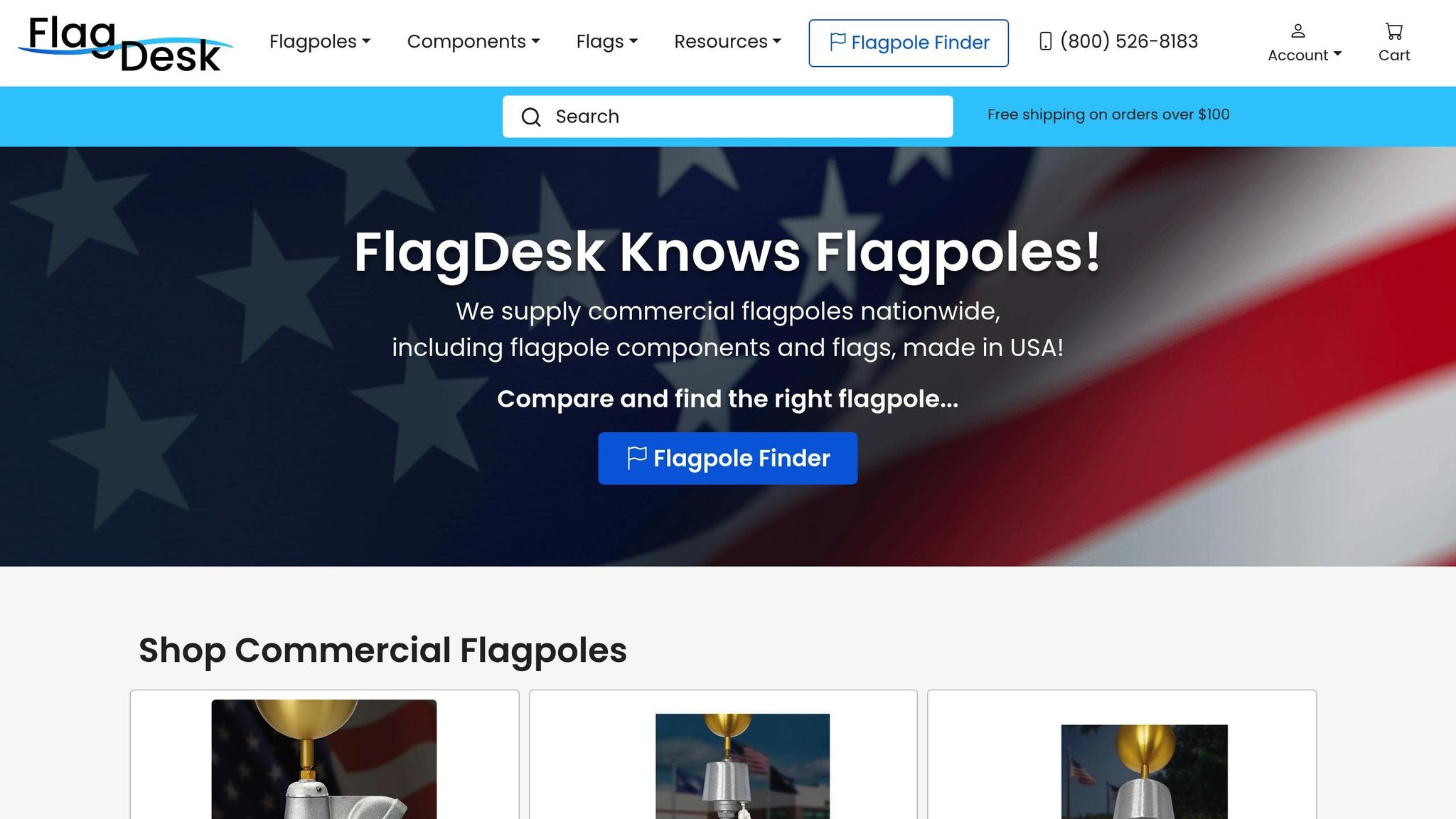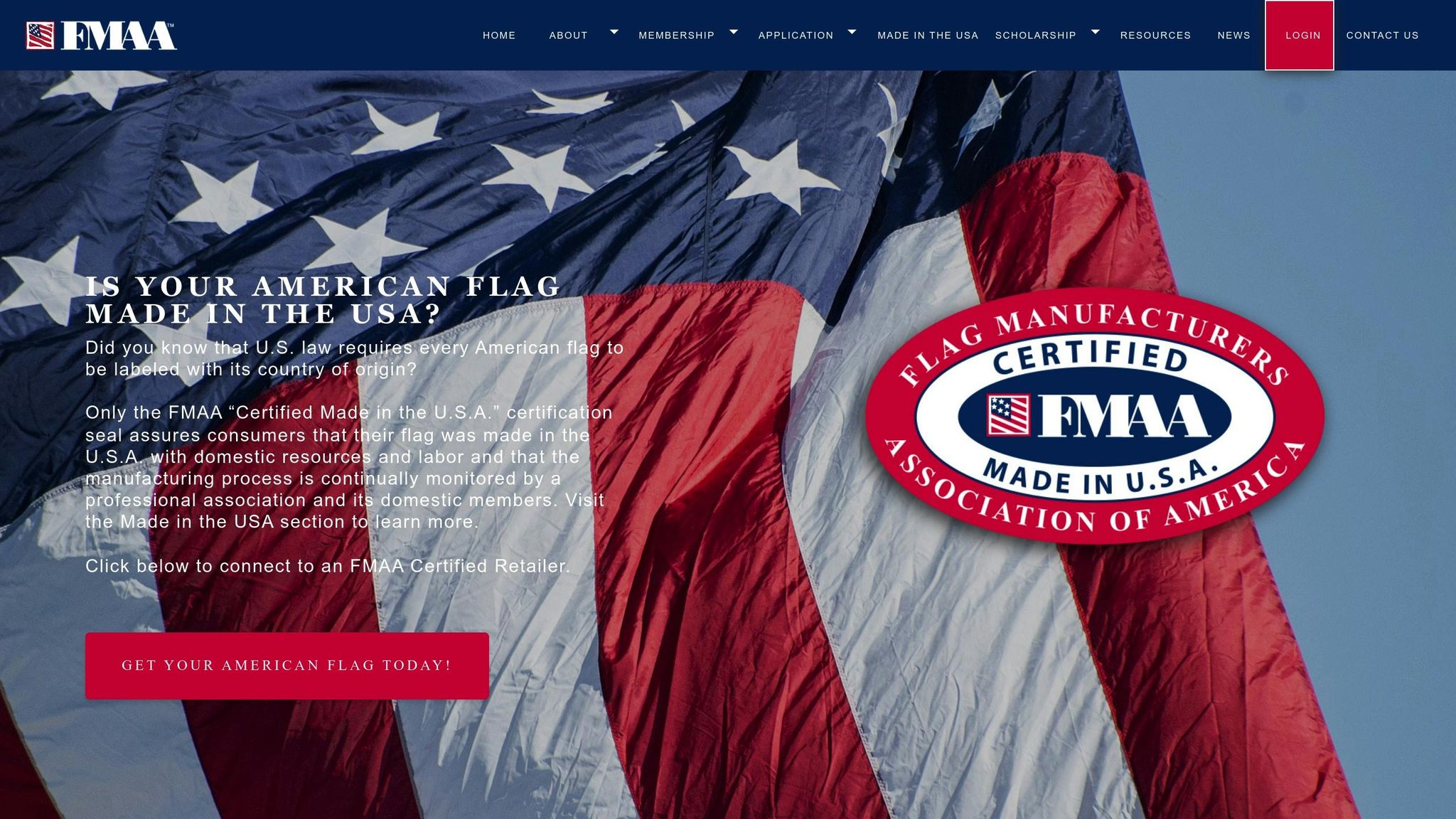Installing a commercial flagpole can be complex, but with the right tools and safety measures, it’s manageable. Here’s a quick breakdown of what you’ll need and what to expect:
- Excavation Tools: Use shovels, post hole diggers, pickaxes, and tampers to create a stable foundation. Ensure the hole is at least 3 feet deep with proper drainage (gravel base under concrete).
- Leveling & Alignment Tools: Use plumb lines and levels to ensure precise vertical alignment during installation. Double-check before the concrete sets.
- Lifting Equipment: Heavier poles (over 25 feet) require cranes or boom trucks for safe lifting.
- Flagpole Hardware: Includes halyard systems (internal or external), snap hooks, flash collars, and retainer rings. Choose based on security, durability, and ease of use.
- Safety Gear: Hard hats, gloves, safety glasses, harnesses, boots, and hearing protection are essential for worker safety.
Key Steps:
- Prepare the site (check for underground utilities and hazards).
- Excavate and lay a stable foundation.
- Align and secure the pole using proper tools.
- Raise the pole safely with lifting equipment.
Pro Tip: If the project feels overwhelming or involves heavy equipment, hire a professional to avoid costly mistakes.
This guide ensures you have what’s needed for a safe and durable flagpole installation.
FlagDesk.com | DIY Installing a 30 Foot Flagpole (Find Tips Here)

Required Tools for Commercial Flagpole Installation
Installing a commercial flagpole requires the right tools for each stage of the process. Using the correct equipment not only ensures a smooth installation but also helps achieve a professional finish. These tools can be grouped into three main categories: excavation tools, leveling and alignment tools, and lifting equipment.
Excavation Tools
Excavation is the first step, and having the right tools makes all the difference. A tapered shovel works well for removing grass and topsoil, while a post hole digger creates a clean, evenly shaped hole. For tougher ground conditions, a pickaxe is essential to break through compacted soil or roots. A manual pole tamper is also important for smoothing the hole's walls, which helps distribute ground pressure evenly. The hole should be at least 3 feet deep, with a width up to four times the diameter of the pole. To ensure proper drainage, include a 12-inch gravel base layer beneath the concrete footer. Before moving on, clear out any loose soil or debris to prepare for the next steps.
Leveling and Alignment Tools
Precision is key when it comes to leveling and alignment. A 4-foot level is ideal for checking the vertical alignment of the ground sleeve, while a 2-foot level works best for aligning individual pole sections. Weighted plumb lines are great for confirming vertical alignment from all directions. These tools should be used when positioning the ground sleeve and throughout the installation process. Since adjustments become difficult once the concrete begins to set, frequent checks are crucial.
Lifting Equipment
Raising a commercial flagpole requires mechanical lifting tools, especially for heavier materials like stainless steel. Cranes are the go-to option for professional installations, particularly for poles taller than 25 feet. Other heavy machinery, such as augers, boom trucks, and pole cranes, may also be necessary depending on the pole's size and weight. Due to the equipment and expertise involved, working with professionals is highly recommended.
Flagpole Hardware and Accessories
When it comes to commercial flagpoles, the right hardware and accessories are just as important as the pole itself. These components work together to create a reliable system that can handle the challenges of demanding environments. From structural sections to halyard systems and smaller accessories, each part plays a role in ensuring durability and functionality.
Flagpole Sections
At the heart of a commercial flagpole are its structural components. The top truck is a critical piece, connecting the halyard system that moves the flag and supporting any decorative ornaments. Many flagpoles feature a decorative top, such as spun aluminum balls starting at $28.50 or gold anodized eagle ornaments priced at $143.95.
Commercial flagpoles typically stand between 30 and 80 feet tall, requiring robust construction to withstand wind and weather. These poles are designed with sections that either telescope or bolt together, simplifying installation and maintenance.
To meet code requirements, flag illumination is essential. Options like solar LED lights provide energy efficiency, while beacon lights ensure consistent brightness.
Halyard Systems
The halyard system is what allows the flag to be raised and lowered. There are two main types:
- External halyard systems: These feature visible ropes, pulleys, and cleats. They are more affordable but can be prone to vandalism and wear from weather exposure.
- Internal halyard systems: These conceal the ropes within a lockable access door, offering added security and quieter operation. They may use either a cam cleat or a winch system. The winch-based design includes a cable and handle mechanism for smooth flag operation.
Each system has its pros and cons, so selecting the right one depends on your priorities, such as security and ease of use.
Additional Components
Smaller accessories might not grab attention, but they are vital to a flagpole's performance and longevity:
- Snap hooks: These connect the flag to the halyard system. Stainless steel options start at $14.50. Regular inspections can prevent flag loss.
- Flash collars: These provide a polished look at the base of the pole. Spun aluminum versions start at $39.95, while commercial-grade options begin at $59.00.
- Retainer rings: Designed to keep flags from wrapping around the pole, these start at $50.95. Rotating versions help reduce tangling and wear.
- Counterweights: These work with retainer rings to stabilize flags and minimize movement-related wear.
- Cleats: External systems use cast aluminum cleats (starting at $12.95) to secure ropes, while internal systems rely on cam-action cleats inside the access door.
- Ground sleeves: These anchor the pole securely. Commercial-grade replacements start at $305.00.
- Shoe base mounts: These offer alternative installation options, with standard bases priced at $385.00 and tilting versions at $585.00.
When choosing accessories, think about your specific environment and how the flagpole will be used. Keeping a maintenance log can help you track replacements and plan for upgrades as needed.
sbb-itb-4fbc981
Safety Equipment and Best Practices
Installing commercial flagpoles comes with its share of risks, from handling heavy machinery to digging deep foundations. Adhering to safety guidelines not only protects your team but also ensures the job gets done right. OSHA regulations require employers to supply personal protective equipment (PPE) when other safety measures alone can't fully protect workers.
Personal Protective Equipment (PPE)
Wearing the right PPE is non-negotiable on construction sites. OSHA emphasizes the importance of properly fitting PPE, as it improves both safety and comfort.
- Hard hats: Crucial for protecting against falling objects and accidents involving machinery. Ensure the suspension system fits securely for maximum protection.
- Safety glasses: Wraparound designs are ideal for shielding eyes from flying debris, especially during tasks like drilling or excavation.
- Work gloves: Prevent cuts, abrasions, and other injuries. Choose gloves suited to the task - leather for general use, cut-resistant for sharp materials, or chemical-resistant for handling concrete additives.
- Full-body harnesses: Essential for working at heights. A properly adjusted harness distributes forces during a fall and minimizes injury risks.
- Safety boots: Look for boots with steel toes, puncture-resistant soles, and good ankle support to protect against heavy objects and rough terrain.
- Hearing protection: Necessary when operating loud tools like concrete mixers or hydraulic equipment. Use snug ear muffs or correctly inserted earplugs to prevent long-term hearing damage.
Establish clear guidelines for PPE care, fit, and usage. Regularly gather feedback from workers to ensure their gear meets both safety and comfort needs. Once PPE is in place, attention shifts to proper lifting practices.
Safe Lifting Techniques
Flagpoles used in commercial projects can weigh hundreds of pounds, making mechanical lifting equipment essential. Before every lift, assess site conditions, load weight, and crane capacity. Detailed lifting plans are vital for ensuring safe and efficient operations.
- Crane operation: Follow manufacturer guidelines, including load ratings and speed limits. A qualified individual should draft a lifting plan for critical tasks. Secure the crane's swing radius to prevent accidental access.
- Communication: Use standardized hand signals, with radios as a backup when visual signals aren't an option.
- Hardware checks: Inspect slings, shackles, and lifting points before each lift. Use only equipment rated for the load and deploy outriggers to stabilize the crane.
- Weather precautions: Avoid lifting in winds exceeding 20 mph. Workers should never stand directly beneath the pole during a lift to avoid potential hazards, such as snapping or twisting components.
Site Preparation and Hazard Control
A well-prepared worksite reduces risks significantly. Start by addressing potential hazards before any heavy equipment is brought in.
- Utility location: Always call 811 to have underground utilities marked before digging. Striking gas, electric, or water lines can result in injuries, service disruptions, and expensive repairs.
- Overhead hazards: Keep the flagpole’s fall radius plus an extra 10 feet of clearance from power lines to ensure safety.
- Ground stability: A stable foundation is critical. Concrete bases are ideal, but soft or recently disturbed soil may require extra compaction or deeper foundations to prevent leaning or instability.
- Regulatory compliance: Check local zoning laws and secure permits before starting. Some areas require engineering stamps for poles exceeding certain heights.
- Work zone security: Use barriers to keep unauthorized individuals away from excavation sites, crane operations, and storage areas. This minimizes risks like tripping, low visibility, or contact with moving equipment.
Additionally, clear the area of obstructions such as trees, branches, or signage that could interfere with the flagpole’s visibility or movement. Regularly inspect all tools and equipment, including lifting gear, power tools, and safety devices, to maintain a safe working environment. Proper site preparation lays the groundwork for a smooth and secure installation process.
Getting Tools and Accessories from Action Flag

Once safety measures are firmly in place, the next step is gathering high-quality tools and accessories. Action Flag provides a wide range of hardware and accessories tailored for professional flagpole installations, ensuring you have reliable options for your project.
Commercial Flagpoles and Hardware
Action Flag's selection of commercial flagpoles includes aluminum, fiberglass, and steel options, each designed to handle different installation needs. Aluminum flagpoles are lightweight and resistant to corrosion, making them easy to handle and long-lasting. Fiberglass models are ideal for areas with strong winds, offering flexibility and resilience. For projects that demand extra durability or height, steel flagpoles provide unmatched strength.
Their hardware lineup covers everything from ropes to truck assemblies. For example:
- Ropes: Choose from solid braid polyester rope at $0.95 per foot, premium wire-center rope at $121.95 for a 500-foot spool, or Technora flagpole rope halyard at $1.95 per foot (cut to your required length).
- Truck Assemblies: Aluminum external halyard trucks start at $102.95 for poles with 2-3/8" diameters. Internal halyard systems range from $247.95 to $913.95, depending on size and features like stainless steel spindles.
- Additional Components: Snap hooks are priced between $4.93 and $20.83, and beaded retainer ring assemblies range from $48.95 to $120.95, ensuring flags stay securely attached.
These standard products are just the beginning - Action Flag can accommodate unique project requirements with custom solutions.
Custom Solutions and Bulk Orders
If your project involves specific needs or large-scale installations, Action Flag offers custom flagpole configurations and bulk purchasing options. They also provide quantity discounts and dedicated account services for government agencies and non-profits, making it easier to manage budgets on big orders.
FMAA-Certified American-Made Products

Action Flag takes pride in offering FMAA-certified products, ensuring they meet strict quality standards. Their commitment to American manufacturing guarantees reliable performance for commercial flagpole installations.
Conclusion
Installing commercial flagpoles requires the right tools, high-quality materials, and skilled execution to ensure safety and longevity. From excavation machinery and durable foundation materials to precision alignment tools and heavy-duty lifting equipment, every step in the process plays a vital role in creating a stable and reliable installation. These components work together seamlessly, from the initial groundwork to the final assembly.
As the need for durable flagpole installations grows, the market is expanding rapidly. Projections show the Flag Pole Market reaching USD 2.7 billion by 2031, with an impressive 8.3% CAGR between 2024 and 2031. This growth highlights increasing demand across sectors like government facilities, military bases, corporate campuses, and community organizations.
Action Flag has established itself as a leader in commercial flagpole solutions. Their BigFlag Steel Flagpoles, constructed from high-strength A-36 Carbon Steel with seamless joints, meet ANSI/NAAMM FP-1001-97 standards and are built to last. These FMAA-certified, American-made flagpoles represent the highest standards of quality, offering comprehensive support for large-scale projects. Action Flag also provides flexible net terms for cities, counties, and veterans' groups, along with special pricing for bulk orders.
"As an industry leader, our focus is on customer satisfaction, safety, and durable flagpole engineering. We provide commercial-quality flag and display solutions for government, businesses, and veterans' groups. We take immense pride in supporting communities, cities, companies, schools, and patriots who fly our flags in unity, signifying their support for the brave men and women fighting for our great country."
Whether you're managing a single installation or a large-scale project, the right tools, materials, and partners are essential for success. Combining professional-grade equipment, durable materials, and expert guidance ensures flagpole installations that stand the test of time. These installations not only meet safety and compliance standards but also serve as symbols of community pride and unity for years to come.
FAQs
What’s the difference between internal and external halyard systems for commercial flagpoles, and how can I choose the best option?
The key distinction between internal and external halyard systems lies in where the rope that raises and lowers the flag is positioned. With internal halyard systems, the rope is concealed inside the flagpole. This design not only creates a clean, polished look but also protects the rope from harsh weather and vandalism, making it well-suited for settings where security and appearance are priorities. In contrast, external halyard systems feature the rope on the outside of the pole. While this setup is more exposed to the elements and tampering, it’s easier to maintain, quicker to repair, and generally more budget-friendly.
When deciding which system is right for you, think about what matters most for your situation. If you value durability and a tamper-resistant design, an internal system might be the way to go. However, if cost and ease of access for maintenance are more important, an external system could be a better match. Consider factors like your location, budget, and long-term needs to determine the best option for your flagpole.
What steps should I take to ensure my team stays safe during a commercial flagpole installation, especially when using heavy equipment?
When installing a commercial flagpole, safety should always come first. Begin by picking a location free from hazards like overhead power lines or underground utilities. Before starting, inspect all tools and equipment to make sure everything is in good condition and ready for use.
It’s also crucial that your team has proper training. This includes knowing the right lifting techniques, using safety gear appropriately, and understanding how to manage risks effectively.
Take the time to thoroughly assess the site for any potential dangers and secure the area to keep unauthorized individuals out. Don’t forget to check local regulations and secure any necessary permits before beginning the project. By following these precautions, you can help ensure a safe and smooth installation process.
What should I consider when choosing materials and accessories for a commercial flagpole in different weather conditions?
When choosing materials for a commercial flagpole, focusing on durability and resistance to weather is key. Aluminum is a top pick because it’s lightweight, rustproof, and resists corrosion. This makes it perfect for areas with heavy rain, high humidity, or salty air - like coastal regions. For places with strong winds, fiberglass stands out. It’s flexible, doesn’t rust, and can handle tough conditions.
When it comes to accessories, stainless steel is a solid choice. It holds up well against harsh weather and won’t corrode easily. Using weather-resistant hardware, like finials and brackets, adds stability and ensures the flagpole performs well over time. Picking materials and accessories suited to your environment will help your flagpole stay in great shape for years.



















































































